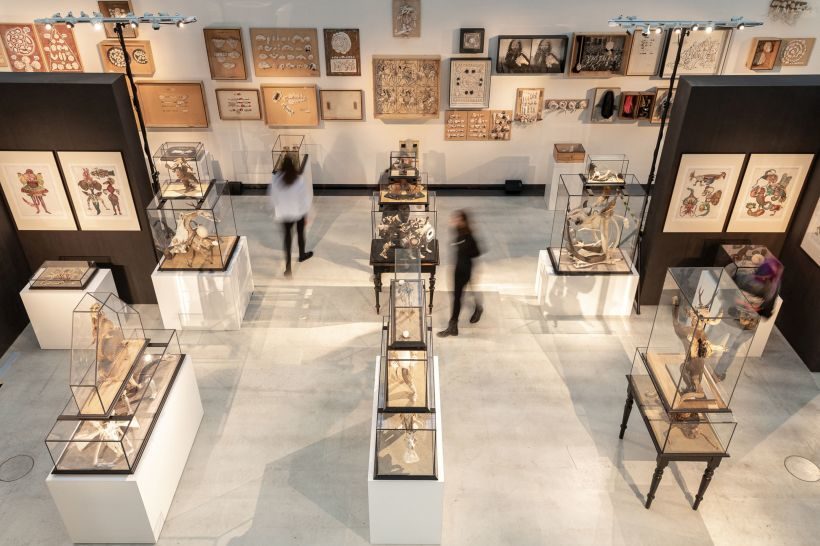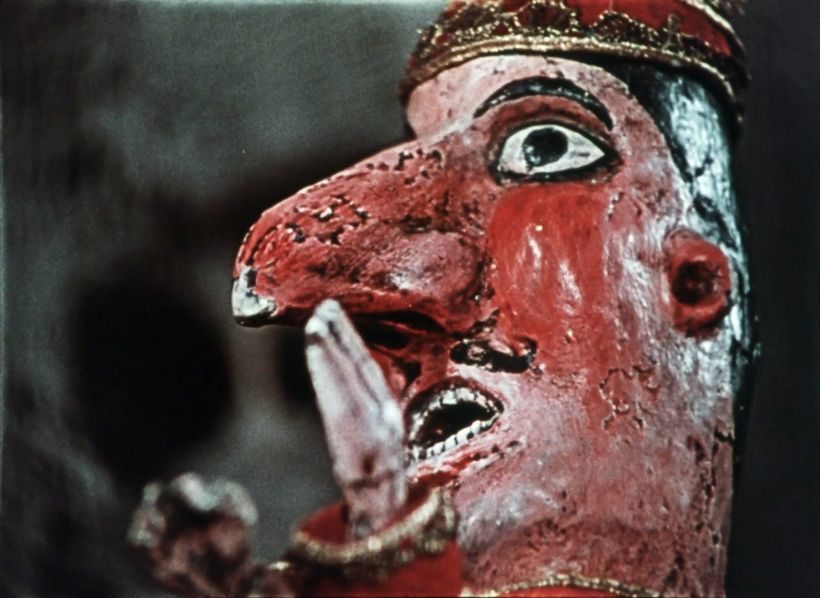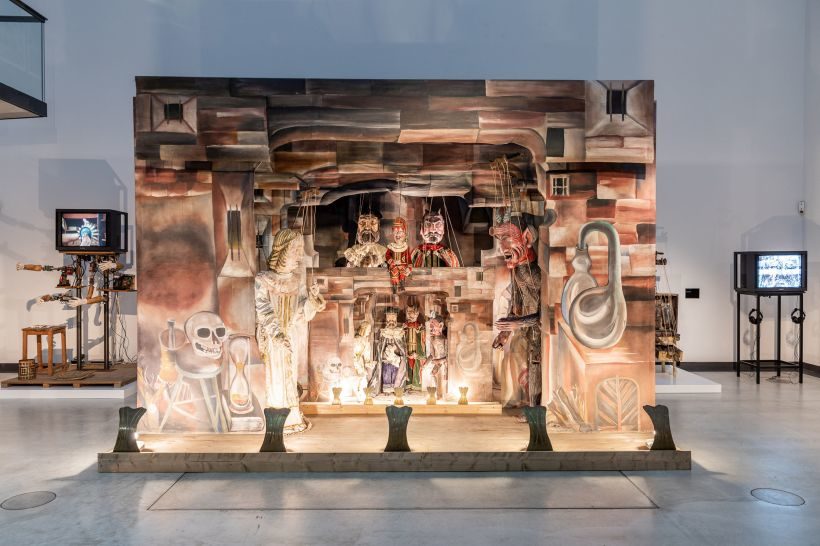On the exhibition ‘Move little hands… “Move!”‘ in the Dresden State Art Collections (18 November 2019 to 8 March 2020)

Exibition Move little Hands… “Move!” Kunsthalle im Lipsiusbau © SKD, Foto: David Pinzer
After passing through the imposing entrance portal and spacious foyer in the Lipsiusbau building in Dresden’s baroque historic centre, we enter more than just an exhibition hall: Within the architecture of this exhibition space with its rectilinear design, the curators of ‘Move little hands… “Move!”‘ have constructed a cathedral of the imagination, brimming with countless assemblages, graphics, ready-mades, paintings, figures and films by Eva and Jan Švankmajer.
The acoustic reception consists of Bohemian brass music, a communist hymn or demonstration chants from the 1989 Velvet Revolution – depending on which moment during the large-scale projection of “The Death of Stalinism in Bohemia” (1990) we enter the exhibition hall. At times, groans of relish and lust from the projection of “Conspirators of Pleasure” (1996) permeate through the tapestry of sounds. And with that, the exhibition’s framing is already defined: A vivid sound collage with Czech idiosyncrasy, in which bodily and political accents form a subversive alliance. The dimension is political from several respects, for freedom is a central theme in the works of Eva and Jan Švankmajer. On an artistic level, they have torn down the borders of restrictive rationality with surrealist energy and relish, even as the real freedom of this artist and private couple was repeated curbed, among others with a state film ban on their work from 1973 to 1980.
In a side aisle to the right, small art chambers are arrayed with exhibits and films that reveal their early oeuvre illustratively and touch upon central themes in their work, such as “reliquaries and alchemy”, or “fetishes and spiritual drawings”. This is mirrored by a side aisle on the left with mid-sized film rooms mainly in an interplay with paintings from Eva Švankmajer and the impressive bodily and complex female perspectives therein.
Yet first of all, despite the exhibition wall at the entrance traversing the space, we inevitably find ourselves being drawn to the central aisle situated behind it. The centrepiece of the exhibition entices us too much with sensual experiences and irritations. The Lipsiusbau is only capable of housing a small part of Švankmajer’s copious, fascinating private collection and his studio on Horní Staňkov. Yet for that, the presentation in the Dresden State Art Collections does convey their chamber-of-wonders character impressively. The strict symmetric arrangement of the display cases and moveable walls with their baroque look is discomposed by the apparently uncontrollable nature of the shapes and bizarre figures. Our eyes seek direction, discover something new time and again, and ramble through a labyrinth of fantastic impressions. In assemblages and in historicising collage prints, disparate animal bodies, additional limbs made of clay, minerals, machine parts and the sexually organic, as well as beetles and other microorganisms merge into an autonomous world beyond our familiar reality. (Side note: Rather than the Stalinist hymns from the large-scale projection, silence would be preferable here so as to listen in fascination to the creatures in the glass cages.) The exposition, which is sparsely furnished with texts otherwise, awaits us here with telling work titles – “Švank-Meyer’s Visual Lexicon” – and short quotes that present an alternative world view: “When dozens of animal species become extinct each year as a result of environmental catastrophes […], only our imagination is capable of replacing them.” (JS) With this twinkling of an eye at current environmental debates, a central Švankmajer motif finds expression: That which has been lived materially or intellectually is a liberated or still to be liberating matter. It provides the substance for creative, associative reshaping. It is telling that the tactile section, where poems are read by hand, is within reach of the cabinet of wonders area. Here, rows of small, rough clay figures permit a sensual experience, as well as everyday objects which appear enigmatic as they are veiled behind dark cloths. The brain touches and feels the world blindly – perceiving and interpreting, in complete contrast to film, where in the case of Jan Švankmajer the eyes and ears assume the tasks of the hand.
Eva und Jan Švankmajer repeatedly avail of puppetry to build a bridge between a material experience of the world and its audio-visual exploration. And accordingly, this is given centre stage in the show. As though drawn to a high altar, everything in Lipsiusbau progresses to the original, illusionistic backdrop scenery from the film “Faust” (1994), together with its life-size puppets. They form a bargaining space between everyday life and alchemy, between a world of things and the human, between rules and freedom. This peak within the exhibition arrangement is promptly framed in a highly contradictory manner. The right side refers to the time prior to the politically prescribed compulsory break with film, and utilises mineralised objects, hand puppets, sadistic cruelty and death as exemplified by “Punch and Judy” (1966). On the left side, carnal lust spreads out in the shape of the masturbation apparatus from “Conspirators of Pleasure” (1996) and in surreal semi-pornographic collages.

Jan Švankmajer, Punch and Judy, 1966 Filmstill © ATHANOR – Film production company, Ltd.
The more than ten film projections mainly arranged chronologically weave diagonally through the exhibition like a soft ribbon. Quantitatively speaking, the eight hours of opening time should just provide enough time to enjoy the wonderful film retrospective in its entirety. In this way, the exhibition does justice to the fact that Eva and Jan Švankmajer are equally at home in the visual arts and in artistic film. They confidently maintain the balance between both interchanging poles, in that the art objects here do not represent props and cheapskate supports to their film world, and the films are not some kind of assistance for the visual arts. Both go subtly hand in hand.
The freestanding art objects repeatedly reveal how powerfully the filmic in the form of time, transformation and animation is inscribed within them. Serial graphic works are reminiscent of storyboards, a row of ceramic jugs – the first one intact, the others after that increasingly feminine and torn open more and more by a hand on their bulge – impact on us like a metamorphosis that has become plastic. A mammal skeleton gives birth to eggs from its fish-head, from which small, fast growing baby spiders lying on the floor then crawl out. Švankmajer’s art objects are dramolettes, compressions of time and the briefest of films, in which the eye assumes the directing. The film editing occurs in the frequently abrupt collisions of the differing material characters. Beautiful but dead-cold agate proliferates parasitically in fluffy-furry animal bodies. The “montaging” of two contrary sensory impressions becomes the narrative fabric. Taking things that to some extent have remained forgotten in drawers for years, Jan Švankmajer creates fetishes and relics, and assigns new tasks and values to them, awakening them to life spiritually. The tactile poems and game boards only permit themselves to be captured through movement and temporality. Jan Švankmajer’s visual art reveals especially that animation is not solely a cinematographic technique, but rather a physics of worlds.

Exhibition Move little hands… „Move!“ © SKD, Foto: David Pinzer
Švankmajers’s cinematic works are internationally famous for their materiality among others, for all their cracks and scratches, the traces of life that mark the world of things and bring it to life. In this feast for the senses, ‘Move little hands… “Move!”‘ illustrates the significance of non-visual experiences of perception so as to be able to capture this film world to its complete extent. The breathtakingly fast, bouncing and stuttering montage – a second filmic characteristic of Švankmajer – is reflected effectively in the show in the form of the unsettling assemblages and collages. Both here and there, our rationality tries to combine the contradictory perceptions into one result. However, it slips and stumbles, bringing forth from the frantic dissolving of the individual parts a chimera that has one leg in and the other one beyond the experience of reality. This evolutionary act of liberation for the imagination constitutes the hymn to the works of Eva und Jan Švankmajer, one that still continues to reverberate in our bodies and minds long after we have left the Lipsiusbau.
Accompanying the exhibition, a cost-free 92-page booklet has been released by the in-house publishing section of the Dresden State Art Collections with texts in German, English and Czech from the curators, as well as from Eva and Jan Švankmajer.
https://lipsiusbau.skd.museum/ausstellungen/move-little-hands-move/